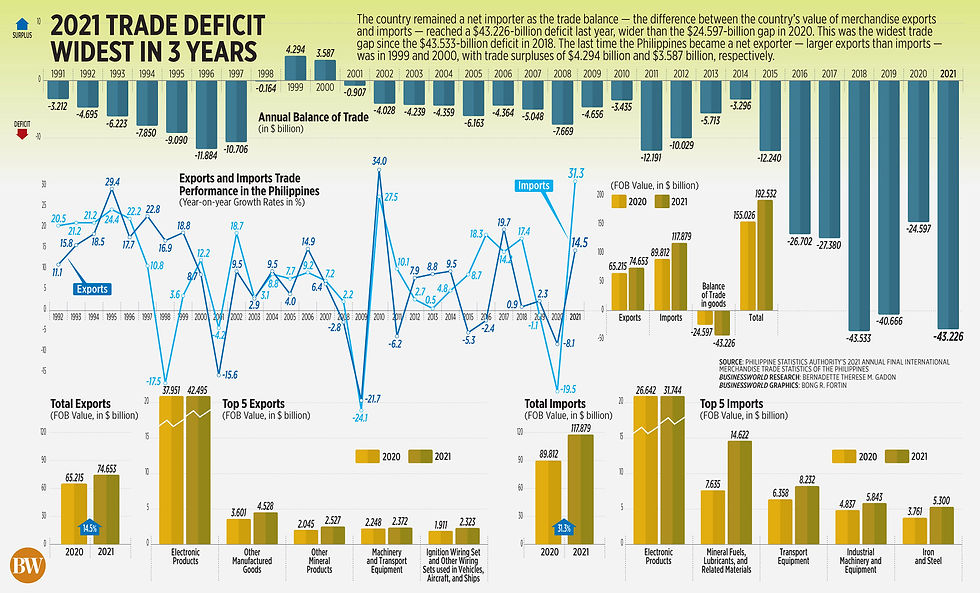2021 trade deficit widest in 3 years
- Ziggurat Realestatecorp
- Apr 22, 2022
- 4 min read
The Philippines’ trade deficit further widened to a three-year high in 2021 as imports continued to outpace exports amid a coronavirus pandemic, latest data from the Philippine Statistics Authority (PSA) showed.
Final results of the PSA’s international trade data showed the value of outbound shipment of goods jumped by an annual 14.5% to $74.653 billion last year, a turnaround from the 8.1% drop in 2020.
This was the fastest since the 19.7% increase in exports in 2017.

Imports likewise surged by a record 31.3% year on year to $117.879 billion from $89.812 billion. Last year’s import growth was a turnaround from the 19.5% decline in 2020.
Last year’s import growth surpassed the 30% full-year target set by the Development Budget Coordination Committee — the inter-agency body that sets the government’s macroeconomic assumptions and targets. Exports, meanwhile, missed the 16% goal.
Both exports and imports were at record levels last year, according to the PSA data dating back to 1991.
The country remained a net importer as the trade balance — the difference between merchandise exports and imports — reached a $43.226-billion deficit last year, wider than the $24.597-billion gap in 2020.
This was the widest trade gap since the $43.533-billion deficit in 2018.
The last time the Philippines became a net exporter was in 1999 and 2000 with trade surpluses of $4.294 billion and $3.587 billion, respectively.
Total trade — the sum of exports and imports — rose by 24.2% to $192.532 billion from $155.026 billion in 2020.
ING Bank N.V. Manila Branch Senior Economist Nicholas Antonio T. Mapa said the jump in trade was due to base effects because 2020 was “an abnormal year” due to the strict lockdowns that caused supply chain disruptions.
He said 2021 was “an exceptional year,” as the economy gradually reopened. Trade levels in the past two years were still below 2019 levels.
“Although we did see a bit of catch up in terms of restocking of inventory and return to some level of normalcy for business activity, the pace of global trade had yet to fully normalize,” he said.
“One reason for this was the fact that the Philippines still faced two lockdown episodes in 2021,” he added, referring to the strict lockdowns implemented to curb a surge in coronavirus disease 2019 (COVID-19) infections in April and August last year.
The country experienced an Omicron-driven COVID-19 surge in January this year, but infections have considerably declined since then. Metro Manila and other areas have been under the most lenient alert level since March.
“The export sector was dominated once more by the mainstay electronics sector, which not only benefited from base effects but also from the stark pickup in demand for these products due to the global chip shortage,” Mr. Mapa said.
“Imports were dominated by the spike in fuel imports, driven by an increase in both volume and value.”
Manufactured goods, which accounted for 82.9% of exports last year, rose by 15% annually to $61.867 billion.
Electronic products, which made up 56.9% of the total export receipts and almost a third of manufactured goods, grew by 12% to $42.495 billion.
Semiconductors, which accounted for 41.7% of exports and more than a fourth of electronic products, increased by 7.4% to $31.161 billion.
Exports of mineral products went up by 16% to $5.908 billion last year from $5.093 billion in 2020. These goods accounted for 7.9% of exports last year.
It was followed by other manufactured goods (up 25.7% annually to $4.528 billion) and other mineral products (up 25.7% to $2.527 billion).
Imports of raw materials and intermediate goods, which accounted for 40.7% of the total import bill last year, jumped by 32.7% to $47.988 billion.
With a 30.1% share of the total, capital goods climbed by 19.2% to $35.471 billion from $29.752 billion.
Consumer goods, which accounted for about 16% of the total bill, rose by 22% to $18.852 billion.
The United States was the main destination of the country’s products, with a 15.9% share at $11.849 billion. It was followed by China (15.5% at $11.553 billion) and Japan (14.4% at $10.725 billion).
China was the country’s major source of imports with $26.799 billion, accounting for 22.7% of the total. It was followed by Japan’s $11.108 billion (9.4% share) and South Korea’s $9.351 billion (7.9%).
The Philippines had trade surpluses with Hong Kong ($6.663 billion), the United States ($4.098 billion) and the Netherlands ($1.683 billion).
It had the widest trade deficits with China ($15.246 billion), Indonesia ($7.579 billion) and South Korea ($6.777 billion).
Mr. Mapa expects demand for electronics this year to remain robust, but it could moderate as global growth slows due to the Russia-Ukraine war. Demand for food exports might rise this year, he added.
“This year, we face new headwinds in the form of renewed supply chain bottlenecks and the disruption brought about by the Ukraine war. Both the International Monetary Fund and World Bank have trimmed their respective global growth projections which suggests that global trade will likely moderate in the near term,” he said.
The IMF raised its Philippine economic growth forecast this year to 6.5% from 6.3%. The World Bank cut its outlook for the country to 5.7% from 5.8% due to the impact of Russia’s invasion of Ukraine.
Both projections fell below the government’s 7-9% target for 2022.
The government expects exports and imports to grow by 6% and 10% this year.
Source: Business World


Comments